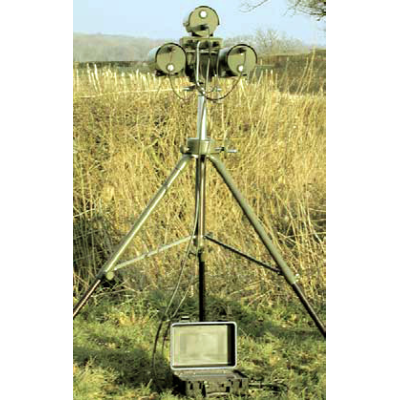DAY & NIGHT OBSERVATION SYSTEM (DANOS) INCORPORATING IMAGE FUSION
GENERAL
DANOS utilises a 3-camera operating system, Night Vision, Thermal Imaging and Day Colour cameras. Each individual sensor is specifically designed to work under differing operating conditions, such as light levels, temperature and prevailing weather conditions. This provides the DANOS Operator the ability to survey the target area over short, medium to long distances, enable detection and recognise & identify targets either by operating cameras independently of each other or via Image Fusion of either two or all three sensors.
DANOS is capable of infinitely variable integration of two or three different sensor technologies at the same time.
Autonomous power is supplied from rechargeable battery pack or from any 12 VDC supply.
Supplied in ruggedised IP66 housings.
Image Fusion provides the operator the ability to fuse together any 2 or all 3 sensor images at the same time and in real time video, or by fusing together any 2 or all 3 camera images at the same time and in real time video.
The DANOS Image Fusion system is ideally suited to Police, Law Enforcement, Defence, Military, Army, Customs, Special Forces and Special Operations to name just a few.
Before outlining the benefits of using Image Fusion, it is necessary to clarify the terminology used in Surveillance Target Acquisition.
TERMINOLOGY
In order to meet and react to any threat from an adversary, the end user requires early information about his dispositions and intentions so that the required resources can be best deployed to react to that threat. There is therefore, a need for general surveillance, which progresses naturally to target acquisition and finally the dealing with of that particular threat. If resources are to be deployed effectively, the threat must be acquired quickly and accurately and dealt with accordingly by using Surveillance Target Acquisition (STA) systems.
STA is defined as follows:
- Surveillance.
Surveillance is the continuous watch over the target area, regardless of weather or time of day to provide timely information and intelligence information. - Target Acquisition.
Target acquisition is the detection, recognition and establishing the location of the target in sufficient detail to permit effective employment of appropriate resources to counter any threat. - Detection.
Detection is the discovery of a potential target. It is accomplished because of a contrast or discontinuity between the target and its background. The observer's reaction is "There's something over there". - Recognition.
Recognition is the determination of the type or class of target, for example "It's a tank". Generally only key feature is necessary to achieve recognition. - Identification.
Identification is the stage at which the true identity of a target is established, for example "It's a T72 tank". Quite fine detail may be necessary to achieve this (wheels, tracks, turret positions etc). - Location.
Location is the determination of the position of the target with sufficient accuracy to allow effective response measures.
Advantages and Disadvantages of Individual Camera Systems
| CCTV Cameras |
Advantages: |
| Image Intensifier (II) / Night Vision. |
Advantages: |
|
Thermal Imagery(TI) |
Advantages: Passive Independent of light levels can operate by day or night over long and short ranges. Capable of penetrating smoke, haze, light camouflage and light rain or mist. Disadvantages: Performances are degraded by heavy rain or fog and are high value and complex items. As with II systems the image is always monochrome and is insensitive to colours. TI sensors cannot achieve identification of human targets, only recognition. |
Benefits of Incorporating Image Fusion into the DANOS Operating System
Image Fusion works by integrating each particular camera video output with one another's thus allowing the DANOS operator to survey the target area using one, two or three different sensor technologies at the same time.
By incorporating Image Fusion technology into the DANOS operating system the end user gets the "best of all worlds".
Image Fusion DANOS is capable of infinitely variable integration of two or three camera outputs by means of simple controls. This enables the operator to select within seconds, the optimum sensor or combination of sensors and the degree of input from each sensor to achieve the optimum image quality and information content for any surveillance scenario.
Switching between single, 2 or 3-camera selection is extremely simple , easy and quick to achieve. Operators are able to survey the target area at short, medium and longer ranges in a wide variety of environmental conditions, using the DANOS operating system incorporating Image Fusion technology.
Image Fusion has taken Surveillance Target Acquisition one stage further by combining together all the advantages of individual Day, Night Vision or Thermal Imaging formats which significantly reduces the disadvantages when all three images are combined together and observed at the same time. Remote operation via Multi Sensor Modular System.
| Camera Options | |
|
Thermal Cameras |
Night Vision Image Intensified Camera |
|
TIU2 75 TIU2 100 TIU2 150 |
Day Camera
Remote operation option via Multi Sensor Modular System |
| Pan/Tilt Positioner | |
|
Speeds (degrees/sec) |
Operational Angles (°) Nominal |
| Control Options | Monitor Options |
|
- Into existing CCTV system. |
- CRT display. |
* Australian & New Zealand procurements -
There are dispensations of UK Ministry of Defence export restrictions for resident purchases by non-government end users ~ re-export from Australia requires both Australian Department of Defence licencing (www.defence.gov.au/ExportControls/) and UK Ministry of Defence permissions.




